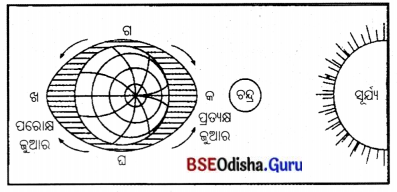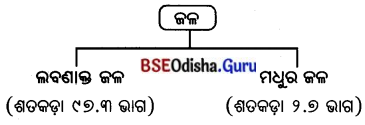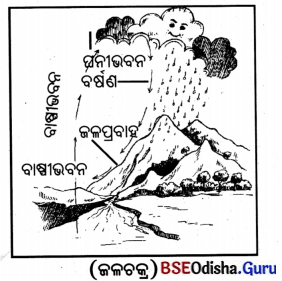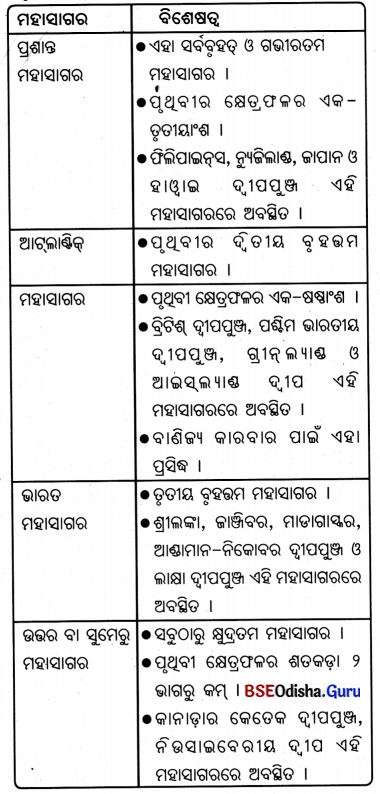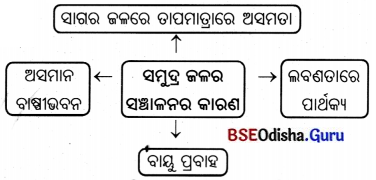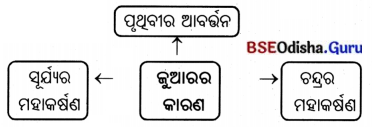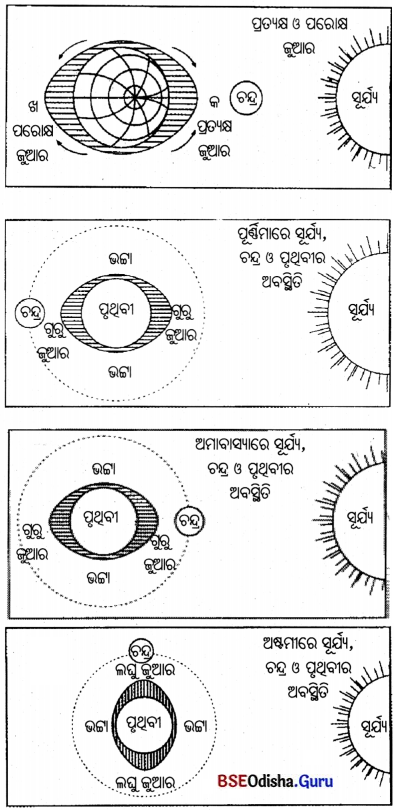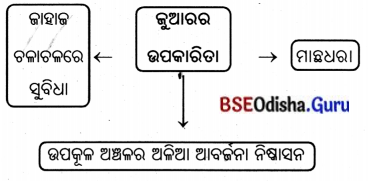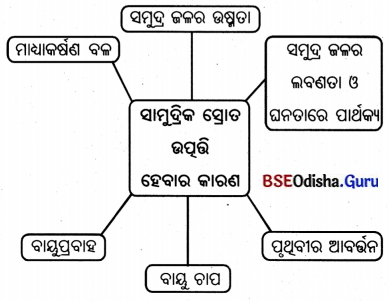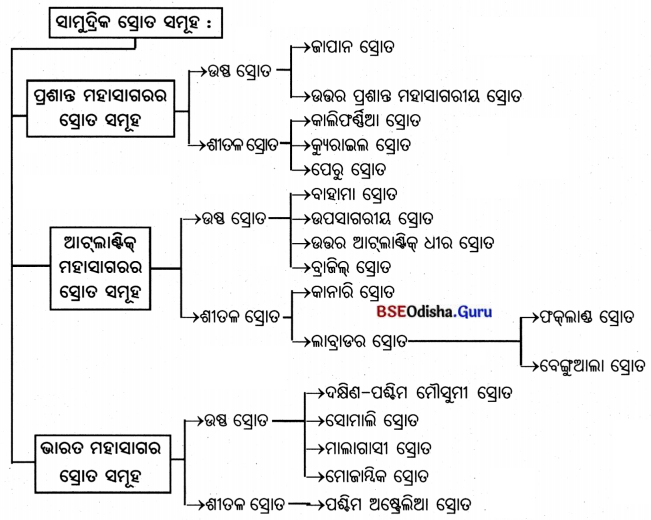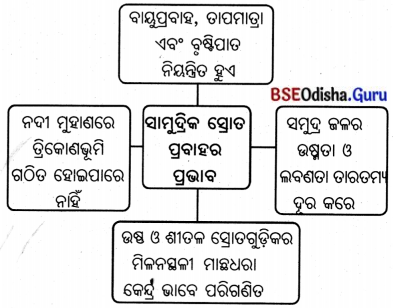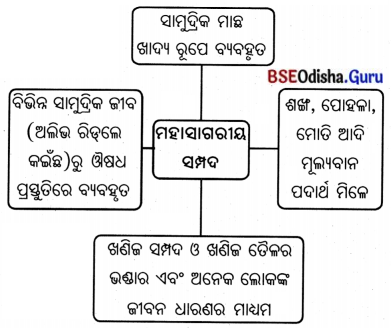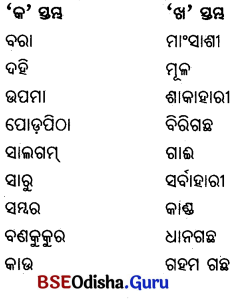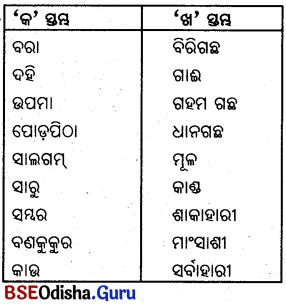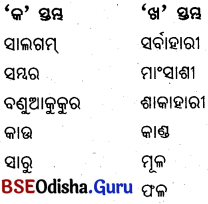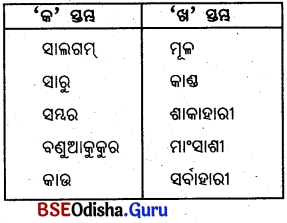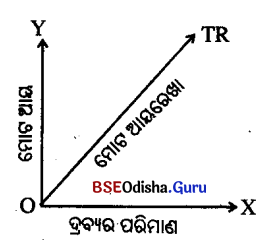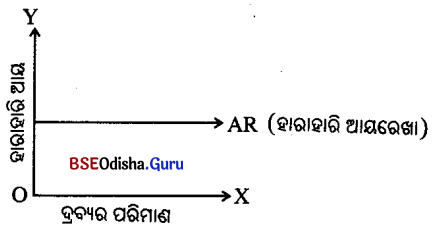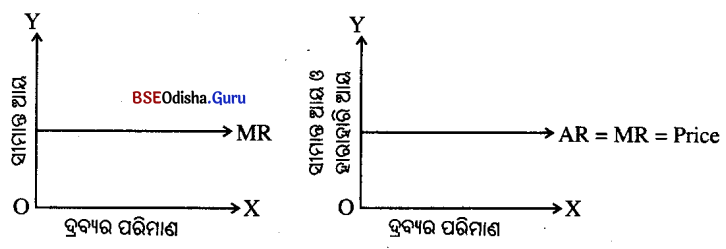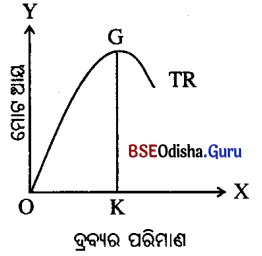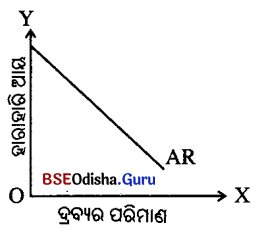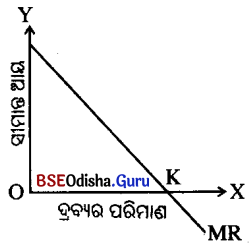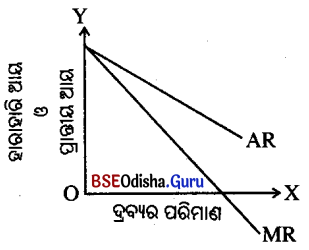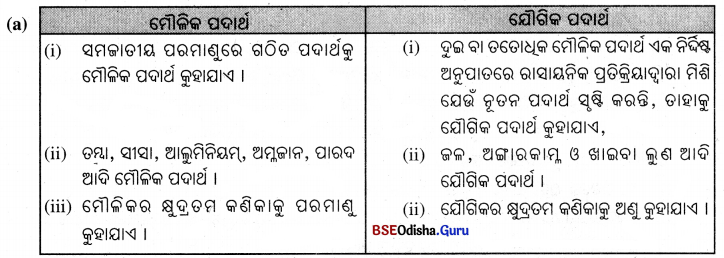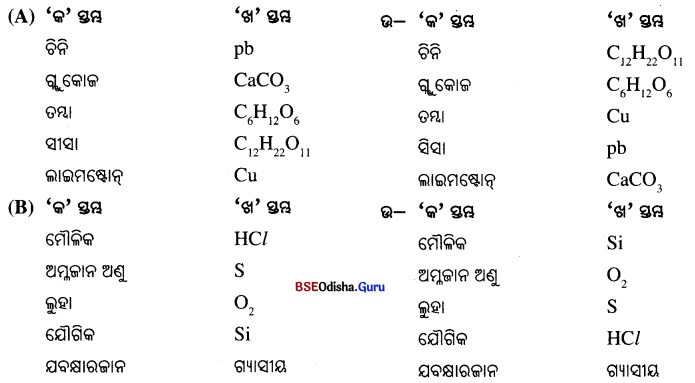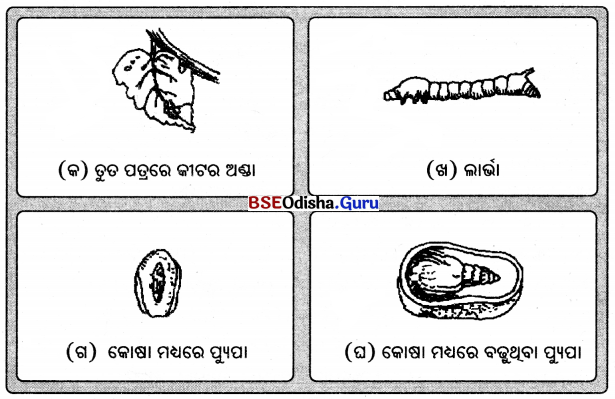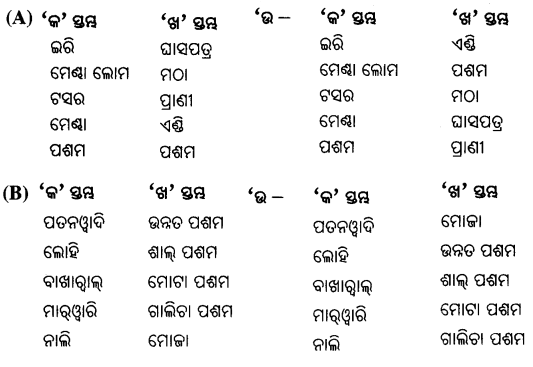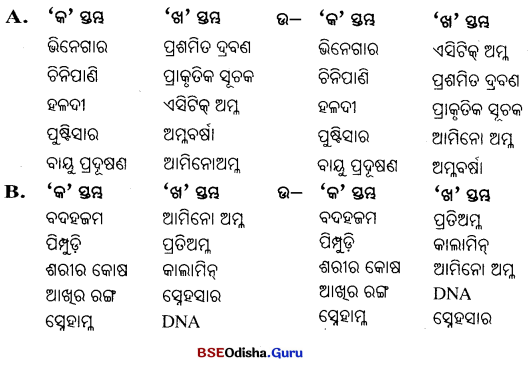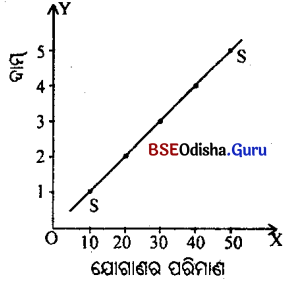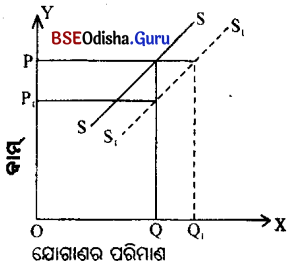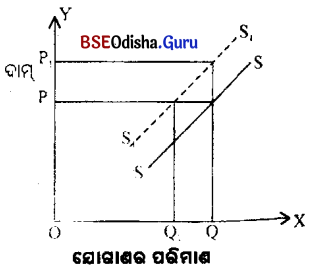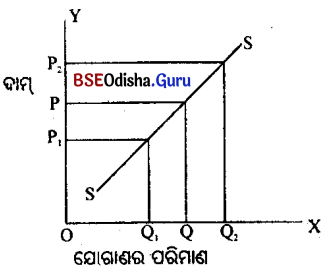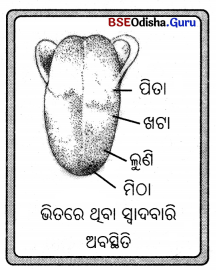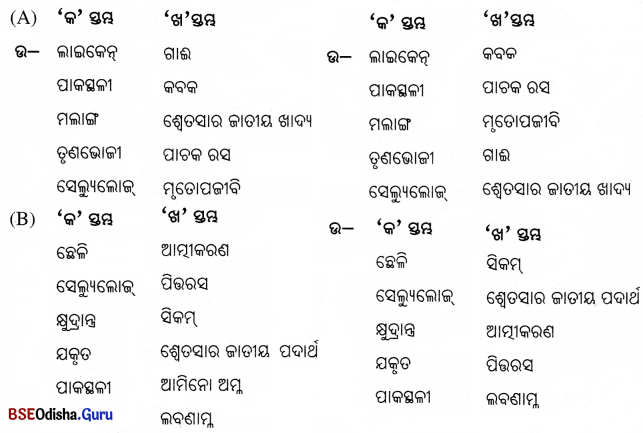Odisha State Board CHSE Odisha Class 12 Economics Solutions Chapter 10 ବଜାର Objective Questions.
CHSE Odisha 12th Class Economics Chapter 10 Objective Questions in Odia Medium
ବସ୍ତୁନିଷ୍ଠ ଓ ଅତିସଂକ୍ଷିପ୍ତ ପ୍ରଶ୍ନୋତ୍ତର
A. ପ୍ରତ୍ୟେକ ପ୍ରଶ୍ନରେ ପ୍ରଦତ୍ତ ବିକଳ୍ପଗୁଡ଼ିକ ମଧ୍ୟରୁ ସଠିକ୍ ଉତ୍ତରଟି ବାଛି ଲେଖ ।
1. କେଉଁ ବଜାରରେ ଅଳ୍ପ ସଂଖ୍ୟକ ବିକ୍ରେତ ଥାଆନ୍ତି ?
(A) ପୂର୍ଣ୍ଣ ପ୍ରତିଯୋଗିତାମୂଳକ ବଜାର
(B) ଏକାଧିକାର ବଜାର
(C) ଅଚ୍ଛାଧ୍ୟାର ବଜାର
(D) ଏକାଧିକାରୀ ପ୍ରତିଯୋଗିତାମୂଳକ ବଜାର
Answer:
(C) ଅଚ୍ଛାଧ୍ୟାର ବଜାର
2. ଆନ୍ତଃ ନିର୍ଭରଶୀଳତା କେଉଁ ବଜାରର ପ୍ରମୁଖ ବୈଶିଷ୍ଟ୍ୟ ?
(A) ପୂର୍ଣ୍ଣ ପ୍ରତିଯୋଗିତାମୂଳକ ବଜାର
(B) ଏକାଧିକାର ବଜାର
(C) ଅଚ୍ଛାଧିକାର ବଜାର
(D) ଏକାଧ୍ୟାକାରୀ ପ୍ରତିଯୋଗିତାମୂଳକ ବଜାର
Answer:
(C) ଅଚ୍ଛାଧିକାର ବଜାର
3. ସମଜାତୀୟ ଦ୍ରବ୍ୟର କାରବାର କେଉଁ ବଜାରରେ ହୋଇଥାଏ ?
(A) ଏକାଧିକାର ବଜାର
(B) ଏକାଧ୍ୟାକାରୀ ପ୍ରତିଯୋଗିତାମୂଳକ ବଜାର
(C) ଅଚ୍ଛାଧିକାର ବଜାର
(D) ପୂର୍ଣ୍ଣ ପ୍ରତିଯୋଗିତାମୂଳକ ବଜାର
Answer:
(D) ପୂର୍ଣ୍ଣ ପ୍ରତିଯୋଗିତାମୂଳକ ବଜାର
4. ପୂର୍ଣ୍ଣ ପ୍ରତିଯୋଗିତାମୂଳକ ବଜାର ଚାହିଦା ରେଖା :
(A) ଆନୁଭୂମିକ ହୋଇଥାଏ
(B) ଉଲ୍ଲମ୍ବ ହୋଇଥାଏ
(C) ନିମ୍ନଗାମୀ ହୋଇଥାଏ
(D) ଊର୍ଦ୍ଧ୍ୱଗାମୀ ହୋଇଥାଏ
Answer:
(A) ଆନୁଭୂମିକ ହୋଇଥାଏ
5. କେଉଁ ବଜାରରେ ଜଣେ ମାତ୍ର ବିକ୍ରେତା ଥାଆନ୍ତି ?
(A) ପୂର୍ଣ୍ଣ ପ୍ରତିଯୋଗିତାମୂଳକ ବଜାର
(B) ଏକାଧ୍ୟାକାରୀ ବଜାର
(C) ଅଚ୍ଛାଧ୍ୟାର ବଜାର
(D) ଏକାଧ୍ୟାକାରୀ ପ୍ରତିଯୋଗିତାମୂଳକ ବଜାର
Answer:
(B) ଏକାଧ୍ୟାକାରୀ ବଜାର
![]()
6. ଅର୍ଥନୀତିରେ ବଜାର କହିଲେ କ’ଣ ବୁଝାଏ ?
(A) ନିର୍ଦ୍ଦିଷ୍ଟ ଭୌଗୋଳିକ ସ୍ଥାନ
(B) କ୍ରେତା ଓ ବିକ୍ରେତାଙ୍କ ମଧ୍ୟରେ ସମନ୍ଵୟ
(C) ଦ୍ରବ୍ୟର ବିକ୍ରୟ
(D) ଉପରୋକ୍ତ ସମସ୍ତ
Answer:
(B) କ୍ରେତା ଓ ବିକ୍ରେତାଙ୍କ ମଧ୍ୟରେ ସମନ୍ଵୟ
7. ନିମ୍ନୋକ୍ତ କେଉଁଟି ପୂର୍ବ ପ୍ରତିଦ୍ବନ୍ଦିତାମୂଳକ ବଜାରର ବୈଶିଷ୍ଟ୍ୟ ନୁହେଁ ?
(A) ଅସଂଖ୍ୟ କ୍ରେତା ଓ ବିକ୍ରେତା
(B) ଅବାଧ ପ୍ରବେଶ ଓ ପ୍ରସ୍ଥାନ
(C) ସର୍ବାଧିକ ଲାଭ
(D) ସମଜାତୀୟ ଦ୍ରବ୍ୟ
Answer:
(C) ସର୍ବାଧିକ ଲାଭ
8. କେଉଁ ବଜାରରେ ପ୍ରତିଯୋଗୀ ପ୍ରତିଷ୍ଠାନମାନେ ଦରଗ୍ରହଣକାରୀ ପ୍ରତିଷ୍ଠାନ ଭାବେ ବିବେଚିତ ହୁଅନ୍ତି ?
(A) ପୂର୍ଣ ପ୍ରତିଯୋଗିତାମୂଳକ ବଜାର
(B) ଏକାଧିକାର ବଜାର
(C) ଅଚ୍ଛାଧିକାର ବଜାର
(D) ଏକାଧିକାରୀ
Answer:
(A) ପୂର୍ଣ ପ୍ରତିଯୋଗିତାମୂଳକ ବଜାର
9. ନିମ୍ନୋକ୍ତ କେଉଁଟି ଏକାଧ୍ୟାର ବଜାରର ବୈଶିଷ୍ଟ୍ୟ ?
(A) ଏକକ ବିକ୍ରେତା ବା ପ୍ରତିଷ୍ଠା
(B) ଅସଂଖ୍ୟ କ୍ରେତା
(C) ପ୍ରତିସ୍ଥାପକ ଦ୍ରବ୍ୟର ଅନୁପସ୍ଥିତି
(D) ଉପରୋକ୍ତ ସମସ୍ତ
Answer:
(D) ଉପରୋକ୍ତ ସମସ୍ତ
10. ଦ୍ରବ୍ୟର ବଜାର ଦର କିଭଳି ନିର୍ଦ୍ଧାରିତ ହୁଏ ?
(A) ଦ୍ରବ୍ୟର ଯୋଗାଣଦ୍ଵାରା
(B) ଦ୍ରବ୍ୟର ଚାହିଦାଦ୍ୱାରା
(C) ଉଭୟ (A) ଓ (B)
(D) ଦ୍ରବ୍ୟ ଉତ୍ପାଦନ ପରିବ୍ୟୟ ଦ୍ବାରା
Answer:
(C) ଉଭୟ (A) ଓ (B)
11. କେଉଁ ବଜାରରେ କ୍ରେତା ବା ବିକ୍ରେତା ଦ୍ରବ୍ୟର ଦରକୁ ପ୍ରଭାବିତ କରିପାରି ନ ଥାନ୍ତି ?
(A) ଅଚ୍ଛାଧ୍ୟାର ବଜାର
(B) ଏକାଧିକାର ବଜାର
(C) ପୂର୍ଣ୍ଣ ପ୍ରତିଯୋଗିତାମୂଳକ ବଜାର
(D) ଏକାଧିକାର ବଜାର
Answer:
(C) ପୂର୍ଣ୍ଣ ପ୍ରତିଯୋଗିତାମୂଳକ ବଜାର
12. ବଜାର ଦର ନିର୍ଦ୍ଧାରଣ କ୍ଷେତ୍ରରେ କାହାର ଅଧିକ ପ୍ରଭାବ ରହିଥାଏ ?
(A) ଯୋଗାଣ
(B) ଚାହିଦା
(C) ଉଭୟ (A) ଓ (B)
(D) କୌଣସିଟି ନୁହେଁ
Answer:
(B) ଚାହିଦା
13. କେଉଁ କାଳରେ ଯୋଗାଣର ବୃଦ୍ଧି ଘଟି ନଥାଏ ?
(A) ବଜାର କାଳ
(B) ସ୍ୱଳ୍ପକାଳ
(C) ଦୀର୍ଘକାଳ
(D) ଉପରୋକ୍ତ କୌଣସିଟି ନୁହେଁ
Answer:
(A) ବଜାର କାଳ
14. ଦୀର୍ଘକାଳୀନ ଦାମ୍ ହେଉଛି :
(A) ବଜାର ଦାମ୍
(B) ବାସ୍ତବ ଦାମ୍
(C) ସ୍ଵାଭାବିକ ଦାମ୍
(D) ଉପରୋକ୍ତ କୌଣସିଟି ନୁହେଁ
Answer:
(C) ସ୍ଵାଭାବିକ ଦାମ୍
15. ସ୍ରାପ୍ୟ ଦ୍ରବ୍ୟର ଦାମ୍ ହେଉଛି :
(A) ବଜାର ଦାମ୍
(B) ସ୍ଵାଭାବିକ ଦାମ୍
(C) ବାସ୍ତବ ଦାମ୍
(D) ଉପରୋକ୍ତ କୌଣସିଟି ନୁହେଁ
Answer:
(B) ସ୍ଵାଭାବିକ ଦାମ୍
16. ପୂର୍ଣ୍ଣ ପ୍ରତିଯୋଗିତା ବଜାରରେ ବିକ୍ରେତା ସଂଖ୍ୟା :
(A) ଦୁଇଜଣ
(B) ବିପୁଳ ସଂଖ୍ୟକ
(C) ଅସଂଖ୍ୟକ
(D) ଜଣେ ମାତ୍ର
Answer:
(B) ବିପୁଳ ସଂଖ୍ୟକ
17. କେଉଁ ବଜାରରେ ଦାମ୍ ଏକ ପ୍ରକାର ଥାଏ ?
(A) ଏକାଧିକାର
(B) ଅଚ୍ଛାଧ୍ୟାକାର
(C) ପୂର୍ଣ୍ଣ ପ୍ରତିଯୋଗିତା
(D) ଉପରୋକ୍ତ କୌଣସିଟି ନୁହେଁ
Answer:
(C) ପୂର୍ଣ୍ଣ ପ୍ରତିଯୋଗିତା
18. କେଉଁ ବଜାର କ୍ଷେତ୍ରରେ ନୂତନ ପ୍ରତିଷ୍ଠାନମାନଙ୍କର ପ୍ରବେଶ ନିଷେଧ ?
(A) ପୂର୍ଣ୍ଣ ପ୍ରତିଯୋଗିତା
(B) ଏକାଧ୍ୟାକାର
(C) ଅଚ୍ଛାଧିକାର
(D) ଉପରୋକ୍ତ କୌଣସିଟି ନୁହେଁ
Answer:
(B) ଏକାଧ୍ୟାକାର
![]()
19. ଏକାଧିକାର ସ୍ଵତ୍ଵ ବିହୀନ ବଜାର ବ୍ୟବସ୍ଥାକୁ କ’ଣ କୁହାଯାଏ ?
(A) ପୂର୍ଣ୍ଣ ପ୍ରତିଯୋଗିତା
(B) ଶୁଦ୍ଧ ପ୍ରତିଯୋଗିତା
(C) ଏକାଧ୍ଵର
(D) ଅଚ୍ଛାଧ୍ୟାକାର
Answer:
(B) ଶୁଦ୍ଧ ପ୍ରତିଯୋଗିତା
20. ଉଭୟ ‘ଏକାଧ୍ଵର’ ଓ ପ୍ରତିଯୋଗିତା ଯେଉଁ ବଜାର ବ୍ୟବସ୍ଥାରେ ପରିଲକ୍ଷିତ ହୁଏ, ସେହି ବଜାର ବ୍ୟବସ୍ଥାକୁ କ’ଣ କୁହାଯାଏ ?
(A) ଏକାଧିକାର
(B) ପୂର୍ଣ୍ଣପ୍ରତିଯୋଗିତାମୂଳକ
(C) ଅଚ୍ଛାଧ୍ୟାକାର
(D) ଏକାଧ୍ୟାକାରୀ ପ୍ରତିଯୋଗିତାମୂଳକ
Answer:
(D) ଏକାଧ୍ୟାକାରୀ ପ୍ରତିଯୋଗିତାମୂଳକ
21. କେଉଁ ବଜାର ସ୍ଥିତିରେ ଉତ୍ପାଦନକାରୀମାନେ ବିଜ୍ଞାପନ ଉପରେ ବହୁଳ ପରିମାଣରେ ଖର୍ଚ୍ଚ କରିଥା’ଛି ?
(A) ଅଚ୍ଛାଧିକାର
(B) ପୂର୍ଣ୍ଣ ପ୍ରତିଯୋଗିତାମୂଳକ
(C) ଏକାଧ୍ୟାକାରୀ ପ୍ରତିଯୋଗିତାମୂଳକ
(D) ଏକାଧିକାର
Answer:
(C) ଏକାଧ୍ୟାକାରୀ ପ୍ରତିଯୋଗିତାମୂଳକ
B. ଶୂନ୍ୟସ୍ଥାନ ପୂରଣ କର ।
1. କୌଣସି ଦ୍ରବ୍ୟର କ୍ରୟ ବିକ୍ରୟ ନିମିତ୍ତ କ୍ରେତା ଓ ବିକ୍ରେତାମାନଙ୍କୁ ପରସ୍ପର ସହିତ ଯୋଗାଯୋଗ କରିବାପାଇଁ କୌଣସି ______________ କୁହାଯାଏ ।
Answer:
ବଜାର
2. ଯେଉଁ ବଜାରରେ ବିପୁଳ ସଂଖ୍ୟକ ବଜାର ଦର ସମ୍ପର୍କରେ ସମ୍ପୂର୍ଣ୍ଣ ଜ୍ଞାନ ଥିବା କ୍ରେତା ଓ ବିକ୍ରେତା ଥାଆନ୍ତି ଏବଂ ସେମାନେ କୌଣସି ପ୍ରତିବନ୍ଧକ ନଥାଇ ଏକ ସମଜାତୀୟ ଦ୍ରବ୍ୟର କିଣାବିକା କରନ୍ତି, ତାହାକୁ _____________ ବଜାର କୁହାଯାଏ ।
Answer:
ପୂର୍ଣ୍ଣ ପ୍ରତିଯୋଗିତାମୂଳକ
3. ପୂର୍ଣ୍ଣ ପ୍ରତିଯୋଗିତାମୂଳକ ବଜାରରେ, ଉତ୍ପାଦନ ପ୍ରତିଷ୍ଠାନଗୁଡ଼ିକ ଶିଳ୍ପ ମଧ୍ୟକୁ ଅବାଧ ପ୍ରବେଶ ଓ _____________ କରିପାରନ୍ତି ।
Answer:
ପ୍ରସ୍ଥାନ
4. _____________ ପରିବହନ ବ୍ୟୟ ପୂର୍ଣପ୍ରତିଯୋଗିତାମୂଳକ ବଜାରର ଏକ ଆବଶ୍ୟକତା ।
Answer:
ଶୂନ୍ଯ
5. ଚାମ୍ବରଲିନ୍ଙ୍କ ମତରେ, ____________ ର ଅନୁପସ୍ଥିତିକୁ ଶୁଦ୍ଧ ପ୍ରତିଯୋଗିତା କୁହାଯାଏ ।
Answer:
ଏକାଧିକାର
6. ପୂର୍ଣ୍ଣ ପ୍ରତିଯୋଗିତାରେ ପ୍ରତ୍ୟେକ ପ୍ରତିଷ୍ଠାନର ଚାହିଦା ରେଖା ____________ ସ୍ଥିତିସ୍ଥାପକ ହୋଇଥାଏ ।
Answer:
ସମ୍ପୂର୍ଣ୍ଣ
7. ପୂର୍ଣ୍ଣ ପ୍ରତିଯୋଗିତାମୂଳକ ବଜାର ଏକ ______________ ବଜାର ଅବସ୍ଥା ଅଟେ ଓ ବାସ୍ତବରେ ଏପ୍ରକାରର ବଜାର ପ୍ରାୟ ଦେଖିବାକୁ ମିଳେ ନାହିଁ ।
Answer:
ତାତ୍ତ୍ଵିକ
8. ଏକାଧିକାର ବଜାର କହିଲେ _____________ ମାତ୍ର ବିକ୍ରେତାଙ୍କୁ ବୁଝାଏ ।
Answer:
ଜଣେ
9. ଏକାଧିକାର ବଜାରରେ, ଏକାଧ୍ୟାକାରୀ ଏପରି ଏକ ଦ୍ରବ୍ୟ ବିକ୍ରୟ କରନ୍ତି ଯାହାର କୌଣସି ନିକଟତମ _____________ ଦ୍ରବ୍ୟ ଉପଲବ୍ଧ ହୁଏ ନାହିଁ ।
Answer:
ବିକଳ୍ପ
![]()
10. ଏକାଧିକାରୀ ଦ୍ରବ୍ୟର ଦର ହ୍ରାସ କରି ବିକ୍ରୟ ବୃଦ୍ଧି କରିପାରନ୍ତି, ଅଥବା ଉତ୍ପାଦନ _______________ କରି ଦ୍ରବ୍ୟର ଦର ବୃଦ୍ଧି କରିପାରନ୍ତି।
Answer:
ହ୍ରାସ
11. ପୂର୍ଣ୍ଣ ପ୍ରତିଯୋଗିତାରେ ଚାହିଦା ରେଖା ଏକ _____________ ସରଳରେଖା ହୋଇଥାଏ ।
Answer:
ଆନୁଭୂମିକ
12. ଏକାଧିକାରୀ _______________ ଚାହିଦାରେଖାର ସମ୍ମୁଖୀନ ହୁଅନ୍ତି ।
Answer:
ନିମ୍ନଗାମୀ
13. _______________ ବଜାରର ଏକ ବୈଶିଷ୍ଟ୍ୟ ହେଉଛି ଦ୍ରବ୍ୟ ବିଭେଦନ ।
Answer:
ଏକାଧ୍ୟାକାରୀ
14. _____________ ବଜାରରେ ଏକାଧିକାର ବଜାରର କିଛି ଲକ୍ଷଣ ଓ ଏକାଧ୍ଵକାରମୂଳକ ପ୍ରତିଯୋଗିତା ବଜାରର କିଛି ଲକ୍ଷଣ ଦେଖାଯାଏ ।
Answer:
ଅଧିକାର
15. ଯେତେବେଳେ ଚାହିଦା ଓ ଯୋଗାଣ ପରସ୍ପର ସହିତ ସମତୁଲ ଅବସ୍ଥାରେ ଥାଆନ୍ତି, ସେତେବେଳେ ନିର୍ଦ୍ଧାରିତ ବଜାର _____________ ଦର କୁହାଯାଏ ।
Answer:
ସନ୍ତୁଳନ
16. ଉପଭୋକ୍ତା ଉପଭୋଗ ସମୟରେ ବଜାର ଦରକୁ_____________ ସହ ତୁଳନା କରନ୍ତି ।
Answer:
ସୀମାନ୍ତ ଉପଯୋଗିତା
17. ଉତ୍ପାଦନକାରୀ ଉତ୍ପାଦନ ସମୟରେ ବଜାର ଦରକୁ _____________ ସହ ତୁଳନା କରନ୍ତି ।
Answer:
ସୀମାନ୍ତ ପରିବ୍ୟୟ
18. ବଜାର କାଳରେ ଚାହିଦା ଓ ଯୋଗାଣ ମଧ୍ୟରେ ଥିବା ସନ୍ତୁଳନ ____________ ଅଟେ ।
Answer:
କ୍ଷଣସ୍ଥାୟୀ
19. କୌଣସି ଏକ ସମୟରେ ବଜାରରେ _____________ ଦାମ୍ଭିକୁ ବଜାର ଦର କୁହାଯାଏ ।
Answer:
ପ୍ରଚଳିତ
20. ଏକ ନିର୍ଦ୍ଦିଷ୍ଟ ସମୟରେ ଚାହିଦା ଓ ଯୋଗାଣଦ୍ବାରା ନିରୂପିତ ହେଉଥିବା ସ୍ଵଳ୍ପକାଳୀନ ସନ୍ତୁଳନ ଦରକୁ _____________ କୁହାଯାଏ ।
Answer:
ବଜାର
21. ଦୀର୍ଘକାଳରେ ଉପଲବ୍ଧ ହେଉଥିବା ଦରକୁ ______________ ଦର କୁହାଯାଏ ।
Answer:
ସ୍ଵାଭାବିକ
22. ସ୍ଵାଭାବିକ ଦର ଏକ _______________ ସନ୍ତୁଳନ ଦର ଅଟେ ।
Answer:
ସ୍ଥିର
23. ବିରଳ ଚିତ୍ରକଳା, ବିରଳ ମୁଦ୍ରା, ପୁରାତନ ପାଣ୍ଡୁଲିପି ଇତ୍ୟାଦି ଦୁଷ୍ଟ୍ରାପ୍ୟ ଦ୍ରବ୍ୟମାନଙ୍କର _____________ ଦର ନଥାଏ ।
Answer:
ସ୍ଵାଭାବିକ
24. ପ୍ରତ୍ୟେକ ଦ୍ରବ୍ୟର ବଜର ଦର ଥାଏ, କିନ୍ତୁ କେବଳ _____________ ଦ୍ରବ୍ୟର ସ୍ଵଭାବିକ ଦର ଥାଏ ।
Answer:
ପୁନରୁତ୍ପାଦନୀୟ
25. ବଜାର ଦର ବାସ୍ତବ ଅଟେ, ମାତ୍ର ସ୍ଵାଭାବିକ ଦର _______________ ଅଟେ ।
Answer:
କାଳ୍ପନିକ
26. ଅଚ୍ଛାଧ୍ୟାର ବିକ୍ରେତା ନିୟନ୍ତ୍ରିତ ବଜାରରେ ________________ ରେଖା ନିର୍ଦ୍ଧାରଣ କରି ହୁଏ ନାହିଁ ।
Answer:
ଚାହିଦା
27. ଅଚ୍ଛାଧ୍ୟାର ବଜାରରେ ______________ ପ୍ରତିଷ୍ଠାନ ଥାଆନ୍ତି ।
Answer:
ସ୍ଵସଂଖ୍ୟକ
28. ପୂର୍ଣ୍ଣାଙ୍ଗ ବଜାର ଏକ _____________ ବଜାର ।
Answer:
ଆଦର୍ଶ
![]()
29. ଏକ ଏକାଧିକାର ବଜାରରେ ନୂତନ ପ୍ରତିଷ୍ଠାନମାନଙ୍କ ପ୍ରବେଶରେ ____________ ଥାଏ ।
Answer:
ପ୍ରତିବନ୍ଧକ
30. ବଜାରକୁ _____________ ନାମରେ ନାମିତ କରାଯାଏ ।
Answer:
ଦ୍ରବ୍ୟ ।
C. ନିମ୍ନଲିଖ ଉକ୍ତିଗୁଡ଼ିକ ଭୁଲ୍ କି ଠିକ୍ ଲେଖ । ରେଖାଙ୍କିତ ଅଂଶର ପରିବର୍ତ୍ତନ ନ କରି ଆବଶ୍ୟକ ସ୍ଥଳେ ସଂଶୋଧନ କର ।
1. ବଜାରକ ସ୍ଥାନର ନାମରେ ନାମିତ କରାଯାଏ ।
Answer:
ଭୁଲ୍ ।
ଠିକ୍ – ବଜାରକୁ ଦ୍ରବ୍ୟର ନାମରେ ନାମିତ କରାଯାଏ ।
2. କ୍ଷଣସ୍ଥାୟୀ ଦ୍ରବ୍ୟ ସ୍ଥଳେ ବିସ୍ତୃତ ବଜାର ଦେଖାଯାଏ ।
Answer:
ଭୁଲ୍ ।
ଠିକ୍ – କ୍ଷଣସ୍ଥାୟୀ ଦ୍ରବ୍ୟ ସ୍ଥଳେ ସୀମିତ ବଜାର ଦେଖାଯାଏ ।
3. ଶୁଦ୍ଧ ବଜାର, ଅଧ୍ୟାର ବଜାରର ଅନୁପସ୍ଥିତିକୁ ବୁଝାଏ ।
Answer:
ଭୁଲ୍ ।
ଠିକ୍ – ଶୁଦ୍ଧ ବଜାର, ଏକାଧ୍ୟାର ବଜାରର ଅନୁପସ୍ଥିତିକୁ ବୁଝାଏ ।
4. ପୂର୍ଣ୍ଣ ପ୍ରତିଯୋଗିତାମୂଳକ ବଜାରରେ ପରିବହନ ପରିବ୍ୟୟକୁ ବିଚାରକୁ ନିଆଯାଏ ।
Answer:
ଭୁଲ୍ ।
ଠିକ୍ – ପୂର୍ବ ପ୍ରତିଯୋଗିତାମୂଳକ ବଜାରରେ ପରିବହନ ପରିବ୍ୟୟକୁ ବିଚାରକୁ ନିଆଯାଏ ନାହିଁ ।
5. ଏକାଧକାର ପ୍ରତିଯୋଗିତାମୂଳକ ବଜାରରେ ବିକ୍ରେତାଙ୍କ ସଂଖ୍ୟା ଅଳ୍ପ ।
Answer:
ଭୁଲ୍ ।
ଠିକ୍ – ଏକାଧ୍ୟାକାର ପ୍ରତିଯୋଗିତାମୂଳକ ବଜାରରେ ବିକ୍ରେତାଙ୍କ ସଂଖ୍ୟା ଅଧ୍ବକ ।
6. ଏକାଧ୍ୟାର ପ୍ରତିଯୋଗିତାମୂଳକ ବଜାରରେ ଜଣେ ଜଣେ ବିକ୍ରେତା ସମୁଦାୟ ଦ୍ରବ୍ୟର ମୂଖ୍ୟ ଅଂଶ ବିକ୍ରି କରିଥା’ନ୍ତି ।
Answer:
ଭୁଲ୍ ।
ଠିକ୍ – ଅଚ୍ଛାଧ୍ୟାକାର ପ୍ରତିଯୋଗିତାମୂଳକ ବଜାରରେ ଜଣେ ଜଣେ ବିକ୍ରେତା ସମୁଦାୟ ଦ୍ରବ୍ୟର ମୁଖ୍ୟ ଅଂଶ ବିକ୍ରି କରିଥା’ନ୍ତି ।
7. ଏକାଧିକାର ବଜାର ଲାଗି ଉତ୍ପାଦକମାନଙ୍କ ମକ୍ତ ଗତିଶୀଳତା ଆବଶ୍ୟକ ।
Answer:
ଭୁଲ୍ ।
ଠିକ୍ – ପୂର୍ବ ପ୍ରତିଯୋଗିତାମୂଳକ ବଜାର ଲାଗି ଉତ୍ପାଦକମାନଙ୍କ ମୁକ୍ତ ଗତିଶୀଳତା ଆବଶ୍ୟକ ।
8. ପୂର୍ଣ୍ଣ ପ୍ରତିଯୋଗିତାମୂଳକ ବଜାର ବିଶୁଦ୍ଧ ବଜାର ଅଟେ ।
Answer:
ଠିକ୍ ।
9. ଦୀର୍ଘକାଳୀନ ସନ୍ତୁଳିତ ଦରକୁ ଅସ୍ଥାୟୀ ବୋଲି କୁହାଯାଏ ।
Answer:
ଭୁଲ୍ ।
ଠିକ୍ – ବଜାର ଦରକୁ ଅସ୍ଥାୟୀ ବୋଲି କୁହାଯାଏ ।
10. ଯୋଗାଣ ସ୍ଥିର ରହି ଚାହିଦାର ବୃଦ୍ଧି ଘଟିଲେ ଦାମ୍ ବୃଦ୍ଧି ଘଟିଥାଏ ।
Answer:
ଠିକ୍ ।
11. ଚାହିଦା ସ୍ଥିର ରହି ଯୋଗାଣର ହ୍ରାସ ଘଟିଲେ ଦାମ୍ ହ୍ରାସ ଘଟିଥାଏ ।
Answer:
ଭୁଲ୍ ।
ଠିକ୍ – ଚାହିଦା ସ୍ଥିର ରହି ଯୋଗାଣର ହ୍ରାସ ଘଟିଲେ ଦାମ୍ ବୃଦ୍ଧି ଘଟିଥାଏ ।
12. ଉଭୟ ଚାହିଦା ଓ ଯୋଗାଣର ବୃଦ୍ଧି ଘଟିଲେ ସନ୍ତୁଳିତ ଦର ବା ପରିମାଣ ଅପରିବର୍ତ୍ତିତ ରହିବାର ସମ୍ଭାବନା ଥାଏ ।
Answer:
ଠିକ୍ ।
![]()
13. ପୂର୍ଣ୍ଣ ପ୍ରତିଯୋଗିତାମୂଳକ ବଜାରରେ ଦ୍ରବ୍ୟର ବିଭିନ୍ନତା ପରିଲକ୍ଷିତ ହୁଏ ।
Answer:
ଭୁଲ୍ ।
ଠିକ୍ – ପୂର୍ଣ ପ୍ରତିଯୋଗିତାମୂଳକ ବଜାରରେ ଦ୍ରବ୍ୟ ସମଜାତୀୟ ଅଟନ୍ତି ।
14. ଏକାଧିକାର ବଜାରରେ କ୍ରେତା ବିକ୍ରେତାଙ୍କ ସଂଖ୍ୟା ଅସଂଖ୍ୟ ।
Answer:
ଭୁଲ୍ ।
ଠିକ୍ – ଏକାଧ୍ୟାର ବଜାରରେ ଏକମାତ୍ର ବିକ୍ରେତା ଥା’ନ୍ତି ।
15. ଏକାଧିକାର ବଜାରରେ ଉତ୍ପାଦନକାରୀଙ୍କର ଯୋଗାଣ ଉପରେ ସମ୍ପୂର୍ଣ୍ଣ କର୍ତ୍ତୃତ୍ଵ ରହିଥାଏ ।
Answer:
ଠିକ୍
16. ସନ୍ତୁଳନ ଦରରେ ଚାହିଦା, ଯୋଗାଣଠାରୁ ଅଧିକ ହୁଏ ।
Answer:
ଭୁଲ୍ ।
ଠିକ୍ – ସନ୍ତୁଳନ ଦରରେ ଚାହିଦା, ଯୋଗାଣ ସହ ସମାନ ।
17. ଅନ୍ଧାଧିକାର ବଜାରରେ ପ୍ରତିଷ୍ଠାନଗୁଡ଼ିକ ସ୍ଵାଧୀନ ।
Answer:
ଭୁଲ୍ ।
ଠିକ୍ – ଅଚ୍ଛାଧ୍ୟାକାର ବଜାରରେ ପ୍ରତିଷ୍ଠାନଗୁଡ଼ିକ ପରସ୍ପର ନିର୍ଭରଶୀଳ ।
18. ଏକାଧିକାରୀ ପ୍ରତିଯୋଗିତାମୂଳକ ବଜାରରେ ଉତ୍ପାଦ ସମଜାତୀୟ ଅଟନ୍ତି ।
Answer:
ଭୁଲ୍ ।
ଠିକ୍ – ଏକାଧ୍ୟାକାରୀ ପ୍ରତିଯୋଗିତାମୂଳକ ବଜାରରେ ଉତ୍ପାଦ ବିଭେଦିତ ଅଟନ୍ତି ।
19. ଅନ୍ଧାଧୁକାର ବଜାରରେ ବିକ୍ରେତାଙ୍କ ସଂଖ୍ୟା ଅସଂଖ୍ୟ ।
Answer:
ଭୁଲ୍ ।
20. ସ୍ଵାଭାବିକ ଦାମ୍ ହିଁ ବାସ୍ତବ ଦାମ୍
Answer:
ଭୁଲ୍ ।
ଠିକ୍ – ବଜାର ଦାମ୍ ହିଁ ବାସ୍ତବ ଦାମ୍ ।
21. ସ୍ଵାଭାବିକ ଦର ପରିବର୍ତ୍ତନଶୀଳ, ମାତ୍ର ବଜାର ଦର ସର୍ବଦା ସ୍ଥିର ।
Answer:
ଭୁଲ୍ ।
ଠିକ୍ – ସ୍ଵାଭାବିକ ଦର ସର୍ବଦା ସ୍ଥିର, ମାତ୍ର ବଜାର ଦର ପରିବର୍ତ୍ତନଶୀଳ ।
22. ସମସ୍ତ ଦ୍ରବ୍ୟର ସ୍ଵାଭାବିକ ଦାମ୍ ଥାଏ ।
Answer:
ଭୁଲ୍ ।
ଠିକ୍ – ସମସ୍ତ ଦ୍ରବ୍ୟର ବଜାର ଦାମ୍ ଥାଏ ।
23. କେବଳ ପୁନରୁତ୍ପାଦନ ହେଉଥିବା ଦ୍ରବ୍ୟର ସ୍ଵାଭାବିକ ଦାମ୍ ଥାଏ ।
Answer:
ଠିକ୍ ।
24. ବିରଳ ମହାର ସ୍ବାଭାବିକ ଦାମ୍ ଅଛି ।
Answer:
ଭୁଲ୍ ।
ଠିକ୍ – ବିରଳ ମୁଦ୍ରାର ବଜାର ଦାମ୍ ଅଛି ।
25. ପୂର୍ଣ୍ଣ ପ୍ରତିଯୋଗିତାମୂଳକ ବଜାରରେ ଚାହିଦା ରେଖା ଏବଂ ହାରାହାରି ଆୟ ରେଖା ଏକ ଓ ଅଭିନ୍ନ।
Answer:
ଠିକ୍ ।
26. ସ୍ଵଳ୍ପକାଳରେ ପୂର୍ଣ୍ଣ ପ୍ରତିଯୋଗିତାମୂଳକ ବଜାରରେ ପ୍ରତିଷ୍ଠାନ କେବଳ ସ୍ଵାଭାବିକ ଲାଭ ଅର୍ଜନ କରିଥାଏ ।
Answer:
ଭୁଲ୍ ।
ଠିକ୍ – ଦୀର୍ଘକାଳରେ ପୂର୍ଣ୍ଣ ପ୍ରତିଯୋଗିତାମୂଳକ ବଜାରରେ ପ୍ରତିଷ୍ଠାନ କେବଳ ସ୍ବାଭାବିକ ଲାଭ ଅର୍ଜନ କରିଥାଏ ।
27. ଦୀର୍ଘକାଳୀନ ଦର ବଜାର ଦର ଭାବରେ ପରିଚିତ ।
Answer:
ଭୁଲ୍ ।
ଠିକ୍ – ଦୀର୍ଘକାଳନୀ ଦର ସ୍ଵାଭାବିକ ଦର ଭାବରେ ପରିଚିତ ।
28. ସ୍ଵାଭାବିକ ଦାମ୍ ବଜାର ଦାମ୍ ଚାରିପଟେ ଘୂରିବୁଲେ ।
Answer:
ଭୁଲ୍ ।
ଠିକ୍ – ବଜାର ଦାମ୍, ସ୍ଵାଭାବିକ ଦାମ୍ ଚାରିପଟେ ଘୂରିବୁଲେ ।
D. ଗୋଟିଏ ବାକ୍ୟରେ ଉତ୍ତର ଦିଅ ।
1. ବଜାର କାହାକୁ କହନ୍ତି ?
Answer:
କୌଣସି ଦ୍ରବ୍ୟର କ୍ରୟ ବିକ୍ରୟ ନିମିତ୍ତ କ୍ରେତା ଓ ବିକ୍ରେତାମାନଙ୍କୁ ପରସ୍ପର ସହିତ ଯୋଗାଯୋଗ କରିବା ପାଇଁ କୌଣସି ବ୍ୟବସ୍ଥାକୁ ବଜାର କୁହାଯାଏ ।
2. ପୂର୍ଣ୍ଣ ପ୍ରତିଯୋଗିତାମୂଳକ ବଜାର କ’ଣ ?
Answer:
ଯେଉଁ ବଜାରରେ ବିପୁଳ ସଂଖ୍ୟକ ବଜାର ଦର ସମ୍ପର୍କରେ ସମ୍ପୂର୍ଣ ଜ୍ଞାନ ଥିବା କ୍ରେତା ଓ ବିକ୍ରେତା ଥାଆନ୍ତି ଏବଂ ସେମାନେ କୌଣସି ପ୍ରତିବନ୍ଧକ ନଥାଇ ଏକ ସମଜାତୀୟ ଦ୍ରବ୍ୟର କିଣାବିକା କରନ୍ତି, ତାହାକୁ ପୂର୍ଣ୍ଣ ପ୍ରତିଯୋଗିତାମୂଳକ ବଜାର କୁହାଯାଏ ।
![]()
3. ଏକାଧ୍ୟାର କହିଲେ କ’ଣ ବୁଝ ?
Answer:
ଏକାଧ୍ଵର କହିଲେ ସେହି ବ୍ୟବସ୍ଥାକୁ ବୁଝାଏ ଯେଉଁଥରେ ଜଣେ ମାତ୍ର ବିକ୍ରେତା ଏପରି ଏକ ଦ୍ରବ୍ୟ ଉତ୍ପାଦନ କରନ୍ତି, ଯାହାର ବଜାରରେ କୌଣସି ନିକଟତମ ବିକଳ୍ପ ଦ୍ରବ୍ୟ ଉପଲବ୍ଧ ହୁଏ ନାହିଁ ।
4. ଅଚ୍ଛାଧ୍ଵର ବଜାର କ’ଣ ?
Answer:
ଯେଉଁ ବଜାରରେ ଅଳ୍ପ କେତେକ ବିକ୍ରେତା ଥାଆନ୍ତି ଓ ପରସ୍ପରର କାରବାର ବିଷୟରେ ସମ୍ବେଦନଶୀଳ ଥାଆନ୍ତି, ତାହାକୁ ଅଚ୍ଛାଧ୍ଵର ବଜାର କୁହାଯାଏ ।
5. ଏକାଧ୍ୟାର ପ୍ରତିଦ୍ଵହିତାମୂଳକ ବଜାରର ସଂଜ୍ଞା ନିରୂପଣ କର ।
Answer:
ଏକାତ୍କାର ପ୍ରତିଦ୍ବନ୍ଦିତାମୂଳକ ବଜାର କହିଲେ ସେହି ବ୍ୟବସ୍ଥାକୁ ବୁଝାଏ ଯେଉଁଥରେ କି ଉଭୟ ପ୍ରତିଯୋଗିତା ଓ ଏକାଧିକାରର ଉପାଦାନମାନଙ୍କର ସହାବସ୍ଥାନ ଦେଖାଯାଏ ଏବଂ ଏଠାରେ ଏକାଧିକାର ପ୍ରତିଷ୍ଠାନମାନଙ୍କ ମଧ୍ୟରେ ପ୍ରତିଯୋଗିତା ହୋଇଥାଏ ।
6. ପୂର୍ଣ୍ଣ ପ୍ରତିଯୋଗିତାମୂଳକ ବଜାରରେ କିପରି ଦର ଧାର୍ଯ୍ୟ କରାଯାଏ ?
Answer:
ପୂର୍ଣ ପ୍ରତିଯୋଗିତାମୂଳକ ବଜାରରେ ଦ୍ରବ୍ୟର ଯୋଗାଣ ଓ ଚାହିଦା, ଦ୍ରବ୍ୟର ଦର ନିର୍ଦ୍ଧାରଣ କରିଥା’ନ୍ତି ।
7. ସ୍ଵାଭାବିକ ଦର କ’ଣ ?
Answer:
ସ୍ବାଭାବିକ ଦର ଏକ କାଳ୍ପନିକ ଦର ଯାହା ଦୀର୍ଘକାଳୀନ ଯୋଗାଣ ଓ ଚାହିଦାଦ୍ୱାରା ନିର୍ଦ୍ଧାରିତ ହୁଏ ।
8. ବଜାର ଦର କହିଲେ ତୁମେ କ’ଣ ବୁଝ ?
Answer:
ଏକ ନିର୍ଦ୍ଦିଷ୍ଟ ସମୟରେ ଚାହିଦା ଓ ଯୋଗାଣଦ୍ବାରା ନିରୂପିତ ହେଉଥିବା ଦରକୁ ବଜାର ଦର କୁହାଯାଏ ।
9. ସନ୍ତୁଳନ କ’ଣ ?
Answer:
ସନ୍ତୁଳନ ଏପରି ଏକ ପରିସ୍ଥିତିକୁ ବୁଝାଏ ଯେଉଁଠାରେ ଦ୍ରବ୍ୟର ଯୋଗାଣ ପରିମାଣ ଓ ଚାହିଦା ପରିମାଣ ପରସ୍ପର ସହିତ ସମାନ ହୋଇଥାଏ ।
10. ସନ୍ତୁଳନ ଦର କାହାକୁ କୁହାଯାଏ ?
Answer:
ସନ୍ତୁଳନ ଦର ଏକ ଦର ଯେଉଁଥରେ ଗୋଟିଏ ଦ୍ରବ୍ୟର ଚାହିଦାର ପରିମାଣ ଯୋଗାଣ ପରିମାଣ ସହିତ ନିଶ୍ଚିତ ଭାବେ ସମାନ ରହେ ।
11. କେଉଁ ବଜାରରେ ‘ଏକକ ଦାମ୍’ ପ୍ରଚଳନର ସମ୍ଭାବନା ଅଧିକ ?
Answer:
ପୂର୍ଣ୍ଣ ପ୍ରତିଯୋଗିତାମୂଳକ ବଜାରରେ ଏକକ ଦାମ୍ ପ୍ରଚଳନର ସମ୍ଭାବନା ଅଧିକ ।
12. କେଉଁ ବଜାରରେ ଚାହିଦା ରେଖାର ସଠିକ୍ ଆକୃତି ନିର୍ଣ୍ଣୟ କରାଯାଇ ପାରେନା ?
Answer:
ଅନ୍ଧାଧ୍ୟାର ବଜାରରେ ଚାହିଦା ରେଖାର ସଠିକ୍ ଆକୃତି ନିର୍ଣ୍ଣୟ କରାଯାଇ ପାରେନା ।
13. କେଉଁ ବଜାରରେ ଉତ୍ପାଦନକାରୀ ଅତିମାତ୍ରାରେ ପରସ୍ପର ନିର୍ଭରଶୀଳ ?
Answer:
ଅଳ୍ପାଧ୍ଵର ବଜାରରେ ଉତ୍ପାଦନକାରୀ ଅତିମାତ୍ରାରେ ପରସ୍ପର ନିର୍ଭରଶୀଳ ।
14. କେଉଁ ବଜାରରେ ‘ପୂର୍ଣ୍ଣାଙ୍ଗ ବଜାର’ ଓ ଏକାଧିକାର ବଜାରର ବୈଶିଷ୍ଟ୍ୟ ଦେଖିବାକୁ ମିଳେ ?
Answer:
ଏକାଧ୍ୟାକାରୀ ପ୍ରତିଯୋଗିତାମୂଳକ ବଜାରରେ ପୂର୍ଣ୍ଣାଙ୍ଗ ବଜାର ଓ ଏକାଧିକାର ବଜାରର ବୈଶିଷ୍ଟ୍ୟ ଦେଖିବାକୁ ମିଳେ ।
15. କେଉଁ ପ୍ରକାର ଦ୍ରବ୍ୟର ସ୍ବାଭାବିକ ଦାମ୍ ନଥାଏ ?
Answer:
ଦୁଷ୍ପାପ୍ୟ ଓ ପୁନରୁତ୍ପାଦନ ହୋଇପାରୁ ନଥିବା ଦ୍ରବ୍ୟର ସ୍ଵାଭାବିକ ଦାମ୍ ନଥାଏ ।
16. କେଉଁ ସମୟକାଳରେ ସମସ୍ତ ଉପାଦାନ ପରିବର୍ତ୍ତିତ ଅଟନ୍ତି ?
Answer:
ଦୀର୍ଘକାଳରେ ସମସ୍ତ ଉପାଦାନ ପରିବର୍ତ୍ତିତ ଅଟନ୍ତି ।
17. କେଉଁ ସମୟ କାଳରେ ଦ୍ରବ୍ୟର ଯୋଗାଣ ପ୍ରାୟ ଅପରିବର୍ତିତ ରହିଥାଏ ?
Answer:
ବଜାର କାଳରେ ଦ୍ରବ୍ୟର ଯୋଗାଣ ପ୍ରାୟ ଅପରିବର୍ତ୍ତିତ ରହିଥାଏ ।
18. କ୍ରେତା ବାସ୍ତବରେ କେଉଁ ଦାମ୍ ଉପରେ ଦ୍ରବ୍ୟ କ୍ରୟ କରିଥାଏ ?
Answer:
କ୍ରେତା ବାସ୍ତବରେ ବଜାର ଦାମ୍ ଉପରେ ଦ୍ରବ୍ୟ କ୍ରୟ କରିଥାଏ ।
![]()
19. କେଉଁ ଉତ୍ପାଦନକାରୀଙ୍କୁ ଦର ସୃଷ୍ଟିକାରୀ (Price maker) କୁହାଯାଏ ?
Answer:
ଏକାଧିକାର ଉତ୍ପାଦନକାରୀଙ୍କୁ ଦର ସୃଷ୍ଟିକାରୀ କୁହାଯାଏ ।
20. କେଉଁ ଦୃଷ୍ଟିକୋଣରୁ ପୂର୍ଣ୍ଣ ପ୍ରତିଯୋଗିତାମୂଳକ ବଜାରରେ ପରିବହନ ବ୍ୟୟକୁ ବିଚାରକୁ ନିଆଯାଏ ନାହିଁ ?
Answer:
ଦ୍ରବ୍ୟର ଦର ସର୍ବତ୍ର ସମାନ ରଖୁବା ଲାଗି ପରିବହନ ବ୍ୟୟକୁ ବିଚାରକୁ ନିଆଯାଏ ନାହିଁ ।
21. କେଉଁ କାରଣରୁ ବିଭିନ୍ନ ପ୍ରକାର ବଜାର ଦେଖାଯାଏ ?
Answer:
କ୍ରେତା ଓ ବିକ୍ରେତାଙ୍କ ତୁଳନାତ୍ମକ ଶକ୍ତିରୁ ବିଭିନ୍ନ ପ୍ରକାର ବଜାର ଦେଖାଯାଏ ।
22. ଜଣେ କ୍ରେତା ବା ବିକ୍ରେତା ପୂର୍ଣ ପ୍ରତିଯୋଗିତାମୂଳକ ବଜାରରେ ଦାମ୍କୁ ପ୍ରଭାବିତ କରିପାରେ କି ?
Answer:
ଜଣେ କ୍ରେତା ବା ବିକ୍ରେତା ପୂର୍ଣ୍ଣ ପ୍ରତିଯୋଗିତାମୂଳକ ବଜାରରେ ଦାମ୍ଭିକୁ ପ୍ରଭାବିତ କରିପାରନ୍ତି ନାହିଁ ।

